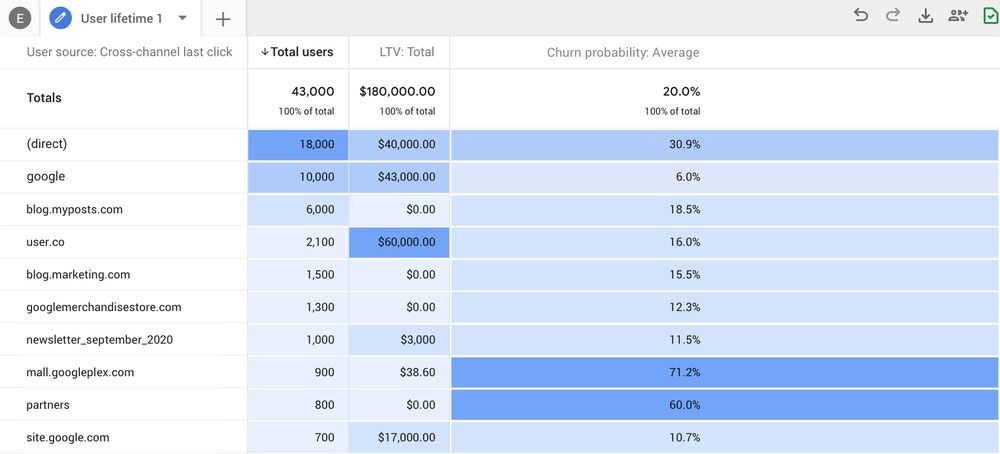Google’s tracking tool Analytics is by far the market leader in web analytics
Now Google delivers a new version of Analytics. Google App + Web Property updates were already in the beta version last year, and the new Analytics version has now been rolled out based on this. Above all, she focuses on machine learning mechanisms in order to quickly provide information on business development and customer behavior.
According to Google, Analytics is now “inherently data protection-oriented” so that companies can rely on Google Analytics even “if changes in the industry such as restrictions on cookies and identifiers” should lead to less data for them.
4 new features in Google Analytics
The 4 most important functions that are available in the “new” Google Analytics are
- Smart insights that use machine learning to identify trends
- Deeper integration with Google Ads.
- Customer-centered data measurement
- More granular data controls
In an announcement, Google cited a study that found it is currently difficult for marketing managers to get a complete picture of customers and to get really useful insights from their data.
Google’s Analytics Update addresses these issues by giving marketers the data they need to improve ROI and track the long-term success of their marketing efforts.
“To help you get a better ROI from your marketing in the long run, we’re building a new, smarter Google Analytics that builds on the foundation of the App + Web feature that we launched in beta last year.
At the core is machine learning, which automatically brings helpful insights to the surface and gives you a complete understanding of your customers across devices and platforms. “
Smarter insights that use machine learning to spot trends
Google Analytics is now able to alert marketers to important developments and trends in their data. This is made possible through the use of Google’s existing machine learning models.
For example, Google Analytics can use website data to identify products that are in demand due to new customer needs.
These skills can help marketers act both proactively and reactively by predicting future customer actions.
Over time, new predictive metrics are added, such as estimating the potential sales that marketers can achieve with a defined group of customers or estimating the future churn rate for a specific product.

Marketers can then use this data to create custom audiences to reach their best customer groups without wastage
Deeper integration of Google Ads
Not surprisingly, the new version of Google Analytics also means, above all, a deeper integration of Google Analytics and Google Ads. Google Ads is still the most important source of revenue for Google.
Custom audiences based on Google Analytics data can be used to target ads with Google Ads.
“With the new integrations of Google Ads into Analytics, it becomes easier to use data to improve the ROI of your marketing.
For example, deeper integration with Google Ads allows you to create target audiences to provide your customers with a more relevant and helpful user experience. “
Google Analytics now measures interactions on the web and in applications, which means it can report on conversions such as: B. YouTube engaging views that take place in the application and on the web.
Marketers now have a more holistic view of their results with the ability to see conversions from YouTube video views, paid Google and non-Google channels, Google search, social media, and email.
Customer-centric data
Google Analytics has evolved from a measurement fragmented by device or platform to a customer-centric measurement.
“The new Analytics offers customer-centric measurements instead of fragmenting measurements by device or platform,” explains Vidhya Srinivasan, Google’s Vice President for Analytics. To do this, Google combines various identification features, such as user IDs assigned by site and app operators or Google’s own data from users who have activated personalized advertising.
Again, this change is designed to give marketers a more complete picture of how customers interact with a company.
For example, marketers can now see whether customers first saw a company through an online ad and later made a purchase using the company’s app.
In the long term, marketers can gain a better understanding of the entire customer lifecycle – from acquisition to conversion to customer loyalty.
“Based on your feedback, we’ve simplified and reorganized reporting so that you can intuitively find marketing insights based on the part of the customer journey that interests you.
For example, you can use the user acquisition report to see which channels are attracting new customers and then use the engagement and retention reports to understand what action those customers are taking and if they are still around after the conversion. “
New approach to collecting and storing user data
Google Analytics now offers more granular data controls that marketers can use to manage how the data is collected and retained.
These controls can also be used to specify how data should be used for advertising.
Marketers can choose when to use customer data to optimize ads and when to limit data usage to measurements.
Google advises that these options can help marketers prepare for a possible future with restricted cookies or identifiers.
“Google uses a flexible measurement approach and will also do modeling in the future to fill in the gaps where the data may be incomplete.
That means you can rest assured that Google Analytics will help you measure your marketing results and meet customer needs now as you navigate the recovery and face uncertainties in the future. ”
The classic user tracking is an obsolete model and it is still unclear which alternative will prevail on the web in the long term and how resilient the resulting database will be. Google also wants to respond to this with its machine learning algorithms. Appropriately trained ML models should fill in data gaps in the future so that marketers can continue to get a comprehensive picture of their target group.
The machine learning models should be able to record conversions across different devices with sufficient accuracy, even if a direct attribution to an individual user is no longer possible. Google also uses the new Google Consent Mode for this purpose.
How to use these new features in Google Analytics
What Google calls the “new” analytics is now the standard for new properties. Google will no longer invest in the old version of GA.
Since marketers won’t change their setup overnight, it makes sense for most companies to create a new Analytics 4 Property (previously Web + App Property) parallel to the existing properties. In this way, the current implementations in Analytics remain intact, while marketers benefit from the features and data processing options of the new version and can familiarize themselves with the new Google Analytics.






